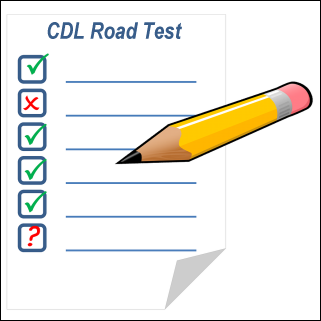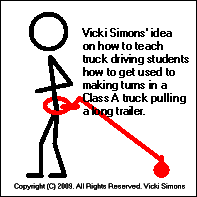 In preparation for your CDL road test, you will need to be thoroughly familiar with the operation of a Class A commercial vehicle.
In preparation for your CDL road test, you will need to be thoroughly familiar with the operation of a Class A commercial vehicle.
The road test, or skills assessment, is one of two tests necessary to obtain a commercial drivers license.
You can do great on the written CDL test and still flunk out on the CDL road test, like a student driver we knew of.
Road test requirements may be different in your state, so make sure that you adequately prepare to pass the test your state gives.
At the time we were in truck driver training school in our home state of South Carolina, a few of our fellow students were from North Carolina.
In addition to everything we had to learn, they also had to learn how to parallel park a big rig.
In a nutshell, here are the skills we had to master on the range, most of which was tested during our individual road tests:
- truck inspections (inside and outside the truck),
- coupling,
- stop line,
- straight line backing,
- serpentine,
- 90-degree alley docking,
- sliding tandems,
- city driving, and
- highway driving.
CDL Road Test: Becoming Acquainted with the Equipment
It was fairly easy for us to learn to do inspections, coupling, the stop line, and straight line backing.
But when it came to maneuvering the trucks and making turns, that was a whole different issue.
When we were in truck driver training school, the trucks that we drove were in decent shape.
Most of them were cabovers. All but one of them was manual steering.
Vicki, who stands about 5’1″ tall and is about half of Mike’s weight, specifically recalls her time wrestling with the steering wheel of one particular manual steering truck.
Its unit number was “C-2” but the student drivers or truck driver trainees in our class all referred to it as “Big Bertha.”
Vicki shares more about her adventure with “Big Bertha” below…
CDL Road Test: Applying the “Serpentine” to a City Driving Situation
 One of the skills that we had to master to pass the road test is the “serpentine,” the weaving of the tractor trailer between cones (simulating fixed objects that the truck has to move between), as the graphic shows.
One of the skills that we had to master to pass the road test is the “serpentine,” the weaving of the tractor trailer between cones (simulating fixed objects that the truck has to move between), as the graphic shows.
This skill is not hard in a car. But a semi tractor trailer has a connection point at the kingpin (making it an “articulated vehicle”).
Learning to turn it around corners or backing it into a simulated 90-degree alley dock proved challenging for both of us.
Not only does a driver have to maneuver the tractor between the cones, but he has to maneuver the trailer between the cones in such a way that he or she does not run over them.
This requires being able to track your trailer’s tandems in your side view mirrors (first on one side, then on the other, however many turns there are).
If you’ve ever seen a truck driver roll over a curb when going around a corner, you’ll know how important the serpentine is!
The first time that Vicki drove a truck in the city, she was instructed to make a right-hand turn from one street onto another.
Although in her mind she knew that she was driving a commercial vehicle, somehow the thought of making sure that the trailer cleared the curb hadn’t quite sunk in.
She came close to hitting a telephone pole.
 At that point, Vicki had an idea of how to teach truck driving students how to get used to making wide turns in a Class A truck pulling a long trailer.
At that point, Vicki had an idea of how to teach truck driving students how to get used to making wide turns in a Class A truck pulling a long trailer.
Fashion an industrial-sized belt (like the type of seat belts found on airplanes that can cinch snuggly around the waist) with a device on the back having a hole into which a hook can be fastened, the hook being connected to a long piece of wood or PVC pipe with a wheel on the bottom (to simulate the trailer).
It can be envisioned that when a student walks around with this training device on, he or she will become accustomed to making wider turns and thus make it easier to envision the distance needed to make turns with a truck.
CDL Road Test: Is There a “Formula” to Backing?
When Vicki first started practicing backing for her CDL test, she was so busy fighting to turn Big Bertha’s steering wheel that she was unable to look at the mirrors or aim the truck correctly.
All she heard from the instructors on the ground were instructions to turn “hard left” or “hard right.”
As you can probably imagine, turning the steering wheel “hard” to the left or right is seldom needed. So, something had to give.
It was when she was put in the driver’s seat of a truck with power steering that she was finally able to gain an understanding of what was happening to the trailer when backing the rig.
One of the driving range instructors insisted that all that was needed to successfully back a truck into a dock via 90-degree turn was some formula that he rattled off.
(Turn the steering wheel so much this way, then so much that way, and you’re in! or so he said!)
Well, that formula didn’t work for us.
Not only that, but every professional driver knows that not all docking situations are the same.
There are such things as 45-degree docks and offset alley docks (as we describe on our back up page).
Well into the course, Vicki (who by all accounts was a fairly reserved person at that point in her life) mustered the courage to tell her instructors that she needed more practice on the 90-degree alley docking.
She worked and worked on that, trying to master the skill.
CDL Road Test: Passing Each Part Successfully to Continue
When we took our road tests for our commercial drivers licenses, we were tested at CDL test cites of Departments of Motor Vehicles.
The way it worked in the early 1990s, with each part that a prospective commercial driver successfully passes, he or she earns the right to go on to the next part.
In the order that we took our road tests – which may or may not be similar to what you will undergo – we were tested on
- pre-trip inspection,
- stop line,
- straight line backing,
- serpentine,
- 90-degree alley dock (with a maximum of three pull-ups), and
- city driving.
If at any point, a driver failed to complete to the satisfaction of the tester a specific skill, that stopped the test.
The first time Mike took his CDL road test, he failed the 90-degree alley docking.
In fact, all three of the students in his group who took the test that day failed the 90-degree alley docking.
(In case you’re wondering, the tester had gotten her Class A CDL commercial drivers license specifically so she could learn how to be a better tester.)
CDL Road Test: Preparing for a Different Dock Every Time
Finally, a new driving range instructor came to work at our truck driving school, a man whose nickname was “Shorty.”
His advise was spot-on regarding every backing situation imaginable:
“Follow your tandems; they’ll never lead you wrong.”
By that, he meant that a driver needs to angle his or her truck based on the position of the trailer’s tandem tires.
(To those of you who have been driving a truck for a long time, this seems so commonsense, but to newbies like we were, it was news.)
Part of the trick of doing a 90-degree alley docking is knowing at what point the rear of the trailer will meet the dock.
One does not want to ram the dock!
For someone who is not familiar with the length of a commercial trailer, knowing when to stop backing can be difficult.
He or she knows the backboard (which is set up to resemble the dock) is back there, but how far “back there” is it?
One day, after long, hard work on the range, Vicki backed up the truck in a 90-degree alley docking situation towards the backboard.
She thought that she had backed up far enough and pulled the brakes.
The next thing she heard was Shorty shouting, “Get out of that truck!”
Vicki wondered if she had backed up too far, causing the rear of the trailer to move the backboard (which is an automatic failure when taking one’s CDL road test).
She climbed down out of the truck and walked toward the back of the trailer and the backboard.
The trailer was just in front of the backboard.
She looked at Shorty and asked, “What’s wrong with it?”
He looked at her and said, “Nothing’s wrong with it! That’s beautiful!”
Vicki was extremely pleased to have mastered “following the trailer’s tandems” under his tutelage.
It was Shorty’s teaching that helped Mike master the 90-degree alley docking.
But there’s a funny story that we have to share with you…
CDL Road Test: Does It Really Matter Who Got it First?
After Mike failed his first CDL road test, Vicki went to take hers.
She had spent a good bit of time mastering the point at which she was weak: the 90-degree alley docking.
She passed her CDL road test the first time.
The instructor made a phone call from the DMV to report what had happened.
When Vicki and the other students who took their tests at the same time returned from the DMV test site, Mike went out to congratulate her.
Then, our classroom instructor, Roger, showed up!
He poked fun at Mike, knowing that Vicki had gotten her CDL first when Mike had failed, by calling out to Mike, “Come here, lumper!”
(A lumper is someone who unloads freight.)
Mike ducked down. Roger called out, “I see you back there, lumper!”
We just had to laugh.
As it turned out, with more practice on the 90-degree alley docking, Mike did just fine on his second CDL road test.
Elsewhere on our site, you read about how we were a husband and wife professional driving team for about 3½ years.
It does not really matter who got whose CDL first, but it is written for time and memorial that in our family, Vicki got hers first!
The lesson to be learned here is that even if you botch your CDL road test the first time, you can learn from your mistakes, spend time mastering the skills where you are weak, and go on to success.
Mike did!
CDL Road Test: Don’t Disqualify Yourself on the Little Stuff
One day before going to take her road test, Vicki was driving a truck with an instructor in the passenger seat and two other students sitting in the sleeper.
She was shocked to hear the instructor tell her that she was going to fail her road test.
When she asked why, he told her that she had taken her hands off the wheel for reasons other than turning the steering wheel or shifting gears.
She emphatically stated that she had not.
But the instructor informed her that she had done so without even realizing it, by unconsciously pushing her glasses back up on her nose!
He said that every time a driver took his or hands off the wheel needlessly during the road test, that was another point off the score.
It goes without saying that when Vicki went to take her CDL road test, she was extremely conscious of keeping her hands on the wheel when not shifting gears.
Once, when she needed to bump her glasses back up her nose, she awkwardly did so by using her upper arm.
CDL Road Test: Testing to Get Hired by a Trucking Company
Having completed the requirements for getting a CDL is a step toward gainful employment in the trucking industry.
Many drivers go to work for trucking companies which require as part of the hiring process that drivers undergo a company road test.
Vicki recalls the paradigm shift of going from driving a cabover in truck driver training school to driving a conventional truck starting with her road test for Swift.
It meant going from being able to see “everything” in front of the truck to having what Mike calls “six feet of shimmering, quivering hood” in front of you, where the driver literally can’t see “everything” in front of the truck.
Although Vicki was carefully watching her right-hand mirror to make sure she wasn’t about to drive into the ditch on the right side of the road, she commented to the tester, a lady named Lynn, that it felt like she was going to.
Lynn understood and responded that Vicki would get used to the feel of the conventional, which is exactly what happened.
Everything else on the company road test went like clockwork.
CDL Road Test: That Unusual Situation on the Road
Some time after we had begun driving as a team, we had a situation in New York State where Mike attempted to back the truck via 90-degree alley docking to a dock inside a building.
It was a little dark in there, so as an aid, Vicki had placed an illuminated flashlight along the line where the left side of the trailer needed to go.
Mike was usually the one who backed their truck into docks.
But that day, for reasons neither of us understand, Mike was unable to get the truck backed into the dock.
Vicki, who had not practiced 90-degree alley docking since her time in truck driver training school, was able to successfully back the truck to the dock.
She did it by “following the tandems.”
CDL Road Test: Master Each Part to Succeed
Every part of the CDL road test is important to master because you will use that skill in your job on the road, usually on a daily basis.
In a nutshell, the key on how to pass your CDL road test to get your commercial drivers license is practice, practice, practice.
For many prospective drivers, the most difficult part of the test is doing a 90 degree alley docking.
We discuss elsewhere how to safely back up a truck in various parking and docking situations.
We’re not ashamed to say that part of the practice we did — to get the hang of how a truck moves (especially when backing into a 90-degree alley dock) — was with a remote control toy semi tractor trailer similar to the one shown here from Amazon.com, with which we have an affiliate relationship.
![]() Money saving tip: If, when you are in truck driver training school, you are assigned to drive a truck where the seat, mirror or other settings don’t adjust correctly for you, speak up and let your instructor know.
Money saving tip: If, when you are in truck driver training school, you are assigned to drive a truck where the seat, mirror or other settings don’t adjust correctly for you, speak up and let your instructor know.
If there is something you don’t understand, you’re shortchanging yourself by not asking questions.
Make sure you understand each aspect of what is required during the CDL road test and that you are able to master each skill. That’s what you’re paying them for.
Return from Pass Your CDL Road Test to Get Your Commercial Drivers License to our Truck Driver Training Schools page or our Truck Drivers Money Saving Tips home page.









